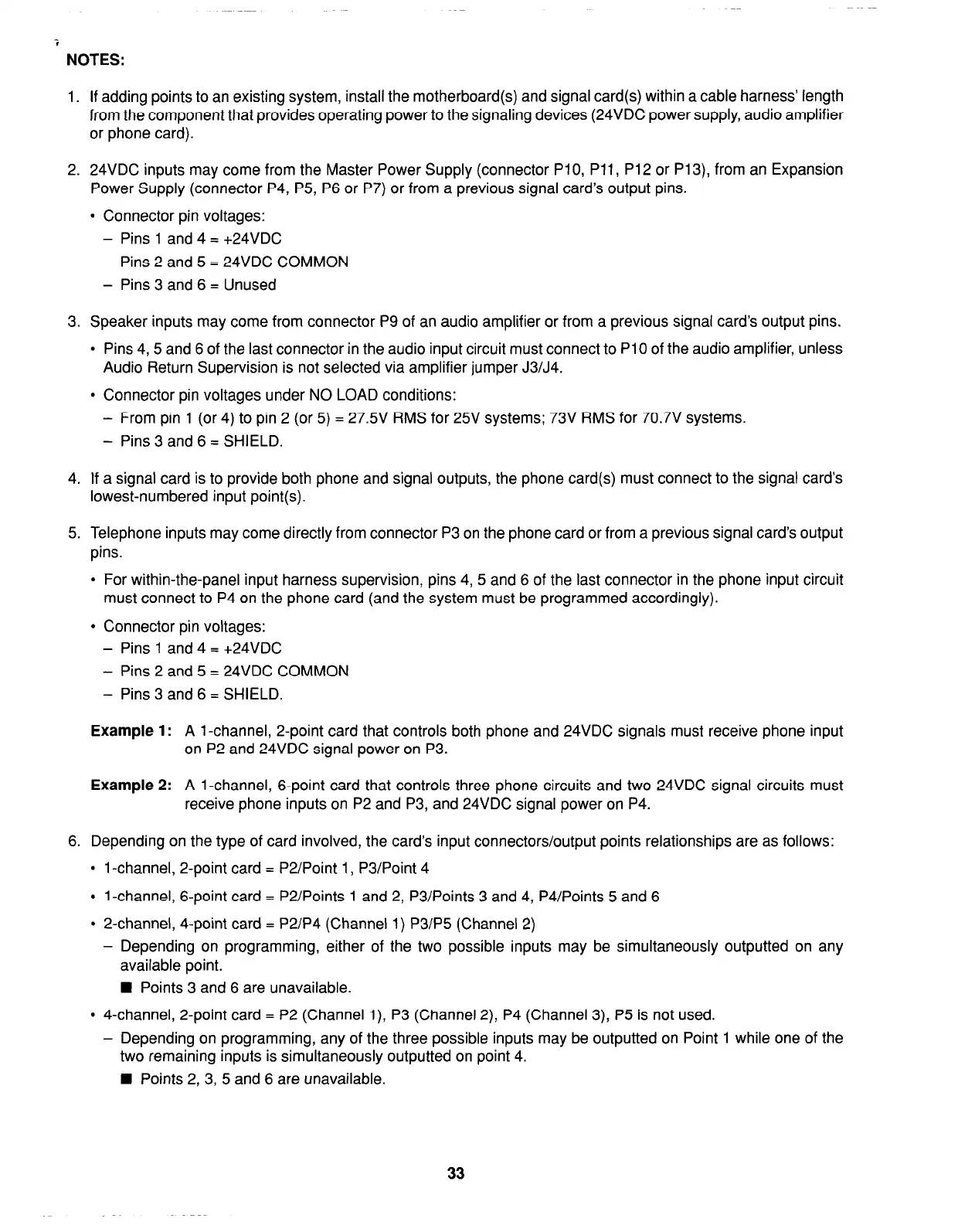7
NOTES:
1. If adding points to an existing system, install the motherboard(s) and signal card(s) within a cable harness’ length
from the component that provides operating power to the signaling devices (24VDC power supply, audio amplifier
or phone card).
2. 24VDC inputs may come from the Master Power Supply (connector PIO, Pll, P12 or P13), from an Expansion
Power Supply (connector P4, P5, P6 or P7) or from a previous signal card’s output pins.
l
Connector pin voltages:
- Pins 1 and 4 = +24VDC
- Pins 2 and 5 = 24VDC COMMON
- Pins 3 and 6 = Unused
3. Speaker inputs may come from connector P9 of an audio amplifier or from a previous signal card’s output pins.
l
Pins 4, 5 and 6 of the last connector in the audio input circuit must connect to PlO of the audio amplifier, unless
Audio Return Supervision is not selected via amplifier jumper J3/J4.
l
Connector pin voltages under NO LOAD conditions:
- From pin 1 (or 4) to pin 2 (or 5) = 27.5V RMS for 25V systems; 73V RMS for 70.7V systems.
- Pins 3 and 6 = SHIELD.
4. If a signal card is to provide both phone and signal outputs, the phone card(s) must connect to the signal card’s
lowest-numbered input point(s).
5. Telephone inputs may come directly from connector P3 on the phone card or from a previous signal card’s output
pins.
l
For within-the-panel input harness supervision, pins 4, 5 and 6 of the last connector in the phone input circuit
must connect to P4 on the phone card (and the system must be programmed accordingly).
l
Connector pin voltages:
- Pins 1 and 4 = +24VDC
- Pins 2 and 5 = 24VDC COMMON
- Pins 3 and 6 = SHIELD.
Example 1:
A 1 -channel, 2-point card that controls both phone and 24VDC signals must receive phone input
on P2 and 24VDC signal power on P3.
Example 2:
A l-channel, 6-point card that controls three phone circuits and two 24VDC signal circuits must
receive phone inputs on P2 and P3, and 24VDC signal power on P4.
6. Depending on the type of card involved, the card’s input connectors/output points relationships are as follows:
l
1 -channel, 2-point card = P2/Point 1, P3/Point 4
l
1 -channel, 6-point card = P2/Points 1 and 2, PB/Points 3 and 4, PWPoints 5 and 6
l
2-channel, 4-point card = P2/P4 (Channel 1) P3/P5 (Channel 2)
- Depending on programming, either of the two possible inputs may be simultaneously outputted on any
available point.
n Points 3 and 6 are unavailable.
l
4-channel, 2-point card = P2 (Channel l), P3 (Channel 2), P4 (Channel 3), P5 is not used.
- Depending on programming, any of the three possible inputs may be outputted on Point 1 while one of the
two remaining inputs is simultaneously outputted on point 4.
n Points 2, 3, 5 and 6 are unavailable.
33

